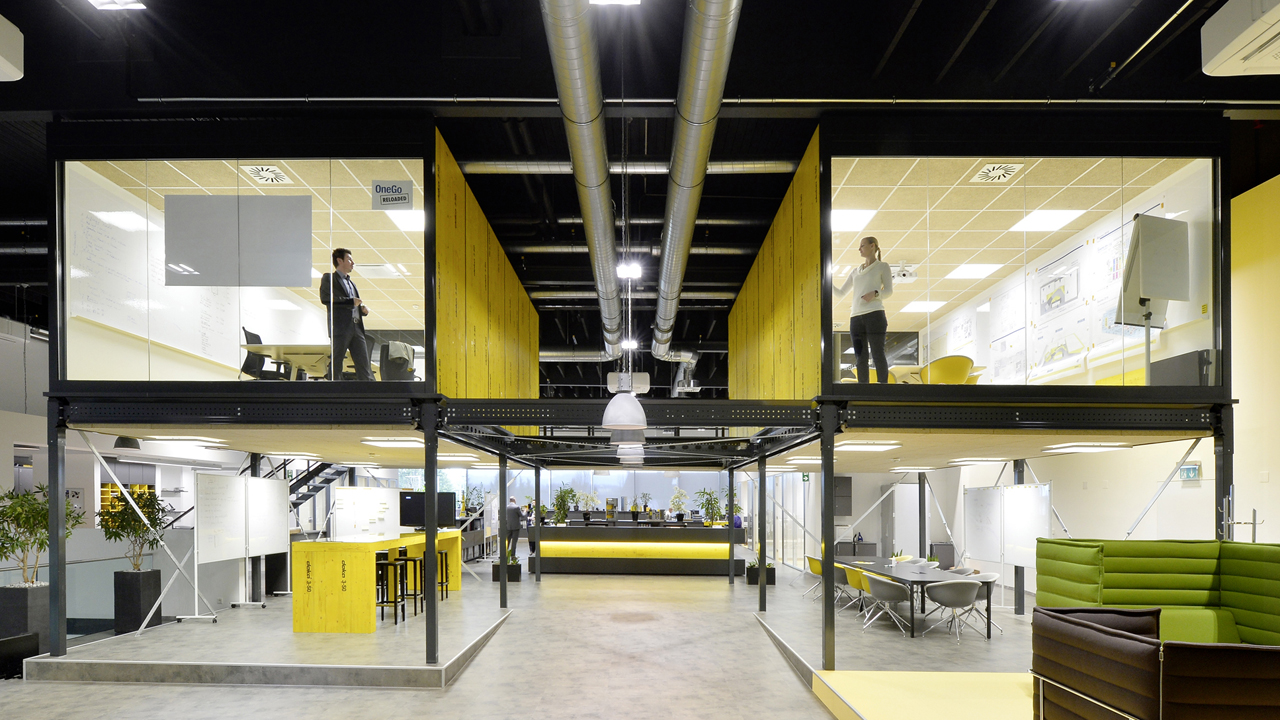Conference in the rocking chair: Activity Based Working.
By Wojciech Czaja, 29.10.2017

What am I working on at the moment? What is my space requirement? And what does the best place for this activity look like? These questions are devoted to “Activity Based Working”. We asked around and put together everything about implementing ABW that needs to be considered.
The meeting has just begun. It is scheduled for a quarter of an hour. Instead of going into the conference room, colleagues this time come together at the yellow lectern. It’s no wonder the materials the table consist of seem familiar. Ultimately the yellow 3-SO formwork panels are used around the globe for in-situ concrete construction sites – from a Lower Austrian single family home to the World Trade Center at Ground Zero to the 828 metre high Burj Khalifa in Dubai. As stated in market leader Doka’s prospectus: “The high performance quality formwork panel for special requirements and many uses.” The catalogue contains what it promises.
“Naturally we are delighted with the wonderful, fresh redesign of our office,” said Evi Roseneder, Head of Corporate Communication. She is based in the new, nearly 700 square metre office in the company’s former ceremonial hall along with her approx. 50 colleagues and employees from the product management and marketing divisions. “But what’s special about our new office is not only the design of the open, spacious rooms but also the implementation of an entirely new working world. Everyone works wherever they feel like at the moment.”
Work where it fits best
In the office technical jargon the new form of working together is called Activity Based Working, abbreviated as ABW. And it implies: Instead of a permanently allocated desk there is a wide range of differently designed workplaces. In contrary to classic desk sharing the focus of ABW is on the choice of the most suitable place of work for each activity profile – or as Roseneder says: “It makes a difference whether I design and brainstorm in a group or hold a confidential conversation in private. The requirements on the workplace are also correspondingly diverse.”
ABW – change of mind in the head
The conversion of Viennese organisational consultant M.O.O.CON was accompanied by a change management process. “Activity Based Working is none other than the conceptual transition from my desk to our office,” explained Bernhard Herzog, Head of Research and Development at M.O.O.CON. “It is also important for a change in thinking to accompany the new workload. Ideally employees grow more active and livelier, not only experiencing a healthier day-to-day working life but also participating more intensively in the entire communication process.”
In any event, according to Herzog, the introduction of ABW should not go hand in hand with the primary desire for efficiency and space saving. “No employer in this world does something like this out of pure altruism. That’s already clear. But I warn against putting this factor in the foreground. First and foremost the aim has to be to offer employees a new way of working with beauty, communication and perhaps also a bit more day-to-day enjoyment. The more diverse and livelier the offer of different workplace situations, the better.” Barbara Masser-Mayerl is also well aware of this. The Communications Manager at the pharmaceutical company Glaxo Smith Kline Austria in the Wiener Euro Plaza found the change management process quite intensive.“
“The open plan office with desk sharing was quite a shock for us. However, with the right preparation it’s certainly possible to master this sort of process.” The intensively accompanied transition lasted one and a half years. The employees could not only be involved in the choice of furniture but also in designing, configuring and naming the individual meeting rooms. Hence the conference rooms are now called “Forest”, “Meadow, “Oasis”, “Spaceship, Wuzzler and Steh-Achterl.
Concept must fit the company
“The most important thing is for Activity Based Working be suitable for the company,” explained Bernhard Kern, Managing Director of Roomware Consulting GmbH, which supports its customers in implementing ABW concepts. “When someone stands in the working café or sits in a silent booth and it isn’t considered to be working hours and creative output then I would advise the company against taking such a step.” A concept like this makes sense above all when employees can act creatively, project-related and autonomously. Then, according to Kern, ABW is an immense communication and quality benefit for the company. “Before thinking about introducing ABW,” advises Astrid Zuwa, Managing Director of designfunktion, Gesellschaft für moderne Büro- und Wohngestaltung, “I recommend analysing the company’s core business and its company culture. For a corporation with a nine-to-five culture something like this would make less sense. If the work culture suits to the company culture,” continues Zuwa, “then Activity Based Working might not go far enough. “You can do what you pleases. We have also already planned law firms with showers, conference rooms with sofa beds and chill-out areas with hammocks.”
Open Space at the first campus
One current – and also much publicised example for ABW – is the recently opened Erste-Campus in the Belvedere quarter in Vienna. An open space concept with Activity Based Working was developed in collaboration with the Berlin interior design office Kinzo for the staff of around 4,500.
A mix of classic desk sharing and a heterogeneous, very diversified centre zone with many different working possibilities emerged. “A wonderful atmosphere of well-being has been created,” said Kuntner. “This is also due to the fact that we quite intensively designed the process.” Our in-house DNA ambassador mediated between planners, the board and employees in the planning and realisation phases and compiled fears and desires. “Old habits are never easy to give up. I can now say, however, that communication has increased and employee autonomy – beyond the hierarchies – has significantly increased. What was still associated with fear and worries in the past is now in most cases an expression of pride and joy.”
(c) Foto: M.O.O.CON, Fotograf: Helge Bauer




